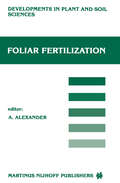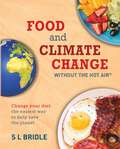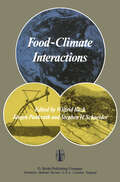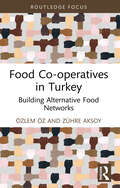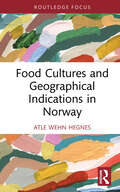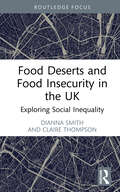- Table View
- List View
The Fokker-Planck Equation: Methods of Solution and Applications (Springer Series in Synergetics #18)
by Hannes Risken Till FrankThis is the first textbook to include the matrix continued-fraction method, which is very effective in dealing with simple Fokker-Planck equations having two variables. Other methods covered are the simulation method, the eigen-function expansion, numerical integration, and the variational method. Each solution is applied to the statistics of a simple laser model and to Brownian motion in potentials. The whole is rounded off with a supplement containing a short review of new material together with some recent references. This new study edition will prove to be very useful for graduate students in physics, chemical physics, and electrical engineering, as well as for research workers in these fields.
Fold Mountains (large print)
by RnibThis is a labelled cross section view of mountains formed by the movement of tectonic plates. A dashed line image border surrounds the diagram. There is a locator dot shown, which will be at the top left of the page when the image is the correct way up. The layers of the earth's crust stretch across the middle of the page. They have been buckled by the pressure of two tectonic plates moving together. At the centre right of the page the crust has sheared causing a fault line to develop.
Fold Mountains (UEB contracted)
by RnibThis is a labelled cross section view of mountains formed by the movement of tectonic plates. A dashed line image border surrounds the diagram. There is a locator dot shown, which will be at the top left of the page when the image is the correct way up. The layers of the earth's crust stretch across the middle of the page. They have been buckled by the pressure of two tectonic plates moving together. At the centre right of the page the crust has sheared causing a fault line to develop.
Fold Mountains (UEB uncontracted)
by RnibThis is a labelled cross section view of mountains formed by the movement of tectonic plates. A dashed line image border surrounds the diagram. There is a locator dot shown, which will be at the top left of the page when the image is the correct way up. The layers of the earth's crust stretch across the middle of the page. They have been buckled by the pressure of two tectonic plates moving together. At the centre right of the page the crust has sheared causing a fault line to develop.
Foliar Fertilization: Proceedings of the First International Symposium on Foliar Fertilization, Organized by Schering Agrochemical Division, Special Fertilizer Group, Berlin (FRG) March 14–16, 1985 (Developments in Plant and Soil Sciences #22)
by A. AlexanderProceedings of the First International Symposium on Foliar Fertilization, organized by Schering Agrochemical Division, Special Fertilizer Group, Berlin (FRG), March 14-16, 1985
Foliations and Geometric Structures (Mathematics and Its Applications #580)
by Aurel Bejancu Hani Reda FarranFollowing the Proceeds of Environmental Crime: Fish, Forests and Filthy Lucre
by Gregory RoseHuge quantities of natural resources are illegally harvested and their proceeds laundered in the Asia-Pacific region, fostering corruption and undermining environmental governance. Most illegal exploitation and pollution occurs in countries with poor governance capacities, but much of the sale for profit and money laundering occurs in mature markets with well-developed governance capacities. Their asymmetrical enforcement capacities can complement each other. This book explores ways to combat illegal fishing and logging in Asia-Pacific region by the use of cooperative legal measures, particularly anti-money laundering and confiscation of proceeds techniques. Contributors to this volume cover themes including: the nature of transnational environmental crime; patterns in laundering of illicit fish and forest products; networks for distribution of illicit products; weaknesses in current systems for assurance of the legality of products; and international legal cooperation to enforce anti-money laundering laws in relation to illicit products. In considering these topics the book explores how the innovative use of anti-money laundering measures and the seizure of criminal proceeds can as policy options to combat transnational fishery and forestry crimes. The book will be of keen interest to scholars and students of environmental law and criminal law, and excellent use for practitioners in natural resources conservation law.
Following the Proceeds of Environmental Crime: Fish, Forests and Filthy Lucre
by Gregory RoseHuge quantities of natural resources are illegally harvested and their proceeds laundered in the Asia-Pacific region, fostering corruption and undermining environmental governance. Most illegal exploitation and pollution occurs in countries with poor governance capacities, but much of the sale for profit and money laundering occurs in mature markets with well-developed governance capacities. Their asymmetrical enforcement capacities can complement each other. This book explores ways to combat illegal fishing and logging in Asia-Pacific region by the use of cooperative legal measures, particularly anti-money laundering and confiscation of proceeds techniques. Contributors to this volume cover themes including: the nature of transnational environmental crime; patterns in laundering of illicit fish and forest products; networks for distribution of illicit products; weaknesses in current systems for assurance of the legality of products; and international legal cooperation to enforce anti-money laundering laws in relation to illicit products. In considering these topics the book explores how the innovative use of anti-money laundering measures and the seizure of criminal proceeds can as policy options to combat transnational fishery and forestry crimes. The book will be of keen interest to scholars and students of environmental law and criminal law, and excellent use for practitioners in natural resources conservation law.
Food: Governance Challenges And Opportunities (Resources)
by Jennifer ClappWe all need food to survive, and forty percent of the world's population relies on agriculture for their livelihood. Yet control over food is concentrated in relatively few hands. Turmoil in the world food economy over the past decade - including the food price crisis, intensification of land grabs, and clashes over rules governing global food trade - has highlighted both the volatility and vulnerability inherent in the way we currently organize this vital sector. At the same time, contrasting extremes of both undernourishment and overnourishment affect a significant proportion of humanity. There is also growing awareness of the serious ecological consequences that stem from industrial models of agriculture that are increasingly spreading worldwide. The revised and updated second edition of this popular book aims to contribute to a fuller understanding of the forces that influence and shape the current global food system. In it, Jennifer Clapp explores how the rise of industrial agriculture, corporate control, inequitable agricultural trade rules, and the financialization of food have each enabled powerful actors to gain fundamental influence on the practices that dominate the world food economy. A variety of movements have emerged that are making important progress in establishing alternative food systems but, as Clapp's penetrating analysis ably shows, significant challenges remain.
Food and Climate Change without the hot air: Change your diet: the easiest way to help save the planet (without the hot air)
by S L BridleDid you know that more than a quarter of the greenhouse-gas emissions that cause climate change come from food?In this ground-breaking and accessible book, Professor Sarah Bridle calculates the greenhouse gas emissions of a selection of our most popular meals and beverages, from a cup of tea and a bowl of cereal to spaghetti bolognese and chicken tikka masala. Breaking down different ingredients and cooking methods to reveal their environmental impact, she finds delicious and sustainable meal alternatives. With this knowledge, we can make a conscious effort to lower our emissions, such as eating more locally grown produce and introducing meat-free days, enabling us to help our planet while also eating healthier food.As well as explaining how our food choices impact the environment and giving practical advice on how to lower emissions, Food and Climate Change without the hot air considers how climate change will affect the food of the future. A rigorously researched discussion of how food and climate change are intimately connected, Bridle also dives into the important topic of food waste and gives valuable tips to avoid leftovers. Illustrated in full colour throughout, this is an essential resource for anyone with eco-anxiety looking for quick and easy ideas to become more sustainable.
Food and Development
by E. M. YoungThe relationship between food and development has always been controversial. Over the last thirty years, development in the north and south has failed to deliver people a decent diet. While some people have too little food and die as a consequence, some people have too much food and die from associated diseases. Furthermore, some methods of food production create social dislocation and deadly environments where biodiversity is eroded and pollution is rampant. While guaranteeing enough food for the world’s inhabitants continues to be a serious challenge, new issues about food have emerged. Food and Development is a lively and lucidly written text which provides a clear and accessible introduction to these complex and diverse food related problems. It explores the continued prevalence of mass under nutrition in the developing world; acute food crises in some places associated with conflict; the emergence of over nutrition in the developing world and the vulnerability of the contemporary global food production system. The text identifies the major problems and analyzes factors at international, national and local scales to understand their continued prevalence. The book concludes by evaluating the potential of some oppositional forces to challenge the hegemony of the contemporary food system. This timely and original text will be invaluable to undergraduates interested in the challenges surrounding food and development. The text is richly filled with case studies from the Global North and South to illustrate the nature and extent of these urgent issues and their interrelated nature. Each chapter contains a range of features to assist undergraduate learning, including: learning objective, key concepts, summaries, discussion questions, further reading and websites, and follow up activities.
Food and Development
by E. M. YoungThe relationship between food and development has always been controversial. Over the last thirty years, development in the north and south has failed to deliver people a decent diet. While some people have too little food and die as a consequence, some people have too much food and die from associated diseases. Furthermore, some methods of food production create social dislocation and deadly environments where biodiversity is eroded and pollution is rampant. While guaranteeing enough food for the world’s inhabitants continues to be a serious challenge, new issues about food have emerged. Food and Development is a lively and lucidly written text which provides a clear and accessible introduction to these complex and diverse food related problems. It explores the continued prevalence of mass under nutrition in the developing world; acute food crises in some places associated with conflict; the emergence of over nutrition in the developing world and the vulnerability of the contemporary global food production system. The text identifies the major problems and analyzes factors at international, national and local scales to understand their continued prevalence. The book concludes by evaluating the potential of some oppositional forces to challenge the hegemony of the contemporary food system. This timely and original text will be invaluable to undergraduates interested in the challenges surrounding food and development. The text is richly filled with case studies from the Global North and South to illustrate the nature and extent of these urgent issues and their interrelated nature. Each chapter contains a range of features to assist undergraduate learning, including: learning objective, key concepts, summaries, discussion questions, further reading and websites, and follow up activities.
Food and Media: Practices, Distinctions and Heterotopias (Critical Food Studies)
by Jonatan Leer Karen Klitgaard PovlsenFood is everywhere in contemporary mediascapes, as witnessed by the increase in cookbooks, food magazines, television cookery shows, online blogs, recipes, news items and social media posts about food. This mediatization of food means that the media often interplays between food consumption and everyday practices, between private and political matters and between individuals, groups, and societies. This volume argues that contemporary food studies need to pay more attention to the significance of media in relation to how we 'do' food. Understanding food media is particularly central to the diverse contemporary social and cultural practices of food where media use plays an increasingly important but also differentiated and differentiating role in both large-scale decisions and most people's everyday practices. The contributions in this book offer critical studies of food media discourses and of media users' interpretations, negotiations and uses that construct places and spaces as well as possible identities and everyday practices of sameness or otherness that might form new, or renew old food politics.
Food and Media: Practices, Distinctions and Heterotopias (Critical Food Studies)
by Jonatan Leer Karen Klitgaard PovlsenFood is everywhere in contemporary mediascapes, as witnessed by the increase in cookbooks, food magazines, television cookery shows, online blogs, recipes, news items and social media posts about food. This mediatization of food means that the media often interplays between food consumption and everyday practices, between private and political matters and between individuals, groups, and societies. This volume argues that contemporary food studies need to pay more attention to the significance of media in relation to how we 'do' food. Understanding food media is particularly central to the diverse contemporary social and cultural practices of food where media use plays an increasingly important but also differentiated and differentiating role in both large-scale decisions and most people's everyday practices. The contributions in this book offer critical studies of food media discourses and of media users' interpretations, negotiations and uses that construct places and spaces as well as possible identities and everyday practices of sameness or otherness that might form new, or renew old food politics.
Food and Nutrition Security in the Kingdom of Saudi Arabia, Vol. 1: National Analysis of Agricultural and Food Security
by Adam E. Ahmed Jameel M. Al-Khayri Azharia A. ElbushraFood and nutrition security is a major concern for Saudi Arabia and the surrounding regions due to the range of challenges they face. These challenges include limited agricultural resources, low self-sufficiency in key food staples, climate change, and high levels of food loss and waste. This book aims to evaluate and analyze the current situation and future prospects of food and nutrition security in Saudi Arabia. Additionally, it seeks to analyze and assess the roles and functions of various institutions related to food security, providing a deeper understanding of the complex problems associated with it. Furthermore, this book aligns with Kingdom Vision 2030, which includes a set of strategies and programs focused on agriculture, food, and water security. It also aligns with the institutional identity of King Faisal University's "Food Security and Environmental Sustainability".The book consists of four volumes. Volume 1, entitled "National Analysis of Agriculture and Food Security" aims to assess the current state of food security in Saudi Arabia, covering key aspects such as agriculture and food resources, food systems, crops, livestock, poultry, fisheries, animal health, food loss and waste, transportation and strategic reserve infrastructure, food security institutions, population, agricultural extension, climate change, agricultural mechanization, smart agriculture, and the utilization of solar energy.This book is highly significant for professionals, researchers, policymakers, and entrepreneurs involved in food and nutrition security in Saudi Arabia, the Gulf Cooperation Council, and various national and international organizations. It offers a comprehensive analysis of the obstacles and possibilities in ensuring food and nutrition security, as well as presenting practical approaches to address these issues. Additionally, graduate students studying in fields related to food and nutrition security will benefit from this book.
Food and Nutrition Security in the Kingdom of Saudi Arabia, Vol. 2: Macroeconomic Policy and Its Implication on Food and Nutrition Security
by Adam E. Ahmed Jameel M. Al-Khayri Azharia A. ElbushraFood and nutrition security is a major concern for Saudi Arabia and the surrounding regions due to the range of challenges they face. These challenges include limited agricultural resources, low self-sufficiency in key food staples, climate change, and high levels of food loss and waste. This book aims to evaluate and analyze the current situation and future prospects of food and nutrition security in Saudi Arabia. Additionally, it seeks to analyze and assess the roles and functions of various institutions related to food security, providing a deeper understanding of the complex problems associated with it. Furthermore, this book aligns with Kingdom Vision 2030, which includes a set of strategies and programs focused on agriculture, food, and water security. It also aligns with the institutional identity of King Faisal University's "Food Security and Environmental Sustainability".The book consists of four volumes. Volume 2 is entitled "Macroeconomic Policy Implications on Food and Nutrition Security". It covers various areas, including food price, loss and waste, processing, finance, trade, investment, quality and safety, consumption patterns, climate change, early warning systems, nutrition institutions, oil revenue, and the significance of date palm and Hassawi rice, genetically modified food, and edible insects in ensuring food and nutritional security.This book is highly significant for professionals, researchers, policymakers, and entrepreneurs involved in food and nutrition security in Saudi Arabia, the Gulf Cooperation Council, and various national and international organizations. It offers a comprehensive analysis of the obstacles and possibilities in ensuring food and nutrition security, as well as presenting practical approaches to address these issues. Additionally, graduate students studying in fields related to food and nutrition security will benefit from this book.
Food and the City in Europe since 1800
by Peter LummelThis fascinating volume examines the impact that rapid urbanization has had upon diets and food systems throughout Western Europe over the past two centuries. Bringing together studies from across the continent, it stresses the fundamental links between key changes in European social history and food systems, food cultures and food politics. Contributors respond to a number of important questions, including: when and how did local food production cease to be sufficient for the city and when did improved transport conditions and liberal commercial relations replace local by supra-regional food supplies? How far did the food industry contribute to improved living conditions in cities? What influence did urban consumers have? Food and the City in Europe since 1800 also examines issues of food hygiene and health impacts in cities, looks at various food innovations and how ’new’ foods often first gained acceptance in cities, and explores how eating fashions have changed over the centuries.
Food and the City in Europe since 1800
by Peter LummelThis fascinating volume examines the impact that rapid urbanization has had upon diets and food systems throughout Western Europe over the past two centuries. Bringing together studies from across the continent, it stresses the fundamental links between key changes in European social history and food systems, food cultures and food politics. Contributors respond to a number of important questions, including: when and how did local food production cease to be sufficient for the city and when did improved transport conditions and liberal commercial relations replace local by supra-regional food supplies? How far did the food industry contribute to improved living conditions in cities? What influence did urban consumers have? Food and the City in Europe since 1800 also examines issues of food hygiene and health impacts in cities, looks at various food innovations and how ’new’ foods often first gained acceptance in cities, and explores how eating fashions have changed over the centuries.
Food, Animals, and the Environment: An Ethical Approach
by Christopher Schlottmann Jeff SeboFood, Animals, and the Environment: An Ethical Approach examines some of the main impacts that agriculture has on humans, nonhumans, and the environment, as well as some of the main questions that these impacts raise for the ethics of food production, consumption, and activism. Agriculture is having a lasting effect on this planet. Some forms of agriculture are especially harmful. For example, industrial animal agriculture kills 100+ billion animals per year; consumes vast amounts of land, water, and energy; and produces vast amounts of waste, pollution, and greenhouse gas emissions. Other forms, such as local, organic, and plant-based food, have many benefits, but they also have many costs, especially at scale. These impacts raise difficult ethical questions. What do we owe animals, plants, species, and ecosystems? What do we owe people in other nations and future generations? What are the ethics of risk, uncertainty, and collective harm? What is the meaning and value of natural food in a world reshaped by human activity? What are the ethics of supporting harmful industries when less harmful alternatives are available? What are the ethics of resisting harmful industries through activism, advocacy, and philanthropy? The discussion ranges over cutting-edge topics such as effective altruism, abolition and regulation, revolution and reform, individual and structural change, single-issue and multi-issue activism, and legal and illegal activism. This unique and accessible text is ideal for teachers, students, and anyone else interested in serious examination of one of the most complex and important moral problems of our time.
Food-Climate Interactions: Proceedings of an International Workshop held in Berlin (West), December 9–12, 1980
by W. Bach J. Pankrath S. H. SchniederProceedings of an International Workshop held in Berlin (West), December 9-12, 1980
Food Co-operatives in Turkey: Building Alternative Food Networks (Routledge Focus on Environment and Sustainability)
by Özlem Öz Zühre AksoyThis book addresses the roles played by food co-operatives in the attempt to build alternative food networks, drawing on an in-depth analysis of case studies in Turkey. While many existing studies focus on food co-operatives and alternative food networks in the Global North, this book provides an important insight into a country from the Global South and, in doing so, not only provides a novel perspective but also challenges the rigid North–South categorization. The book provides a rounded view by examining both a producer and a consumer co-operative: BÜKOOP is a university-based consumer food co-operative, and the Vakıflı co-operative is a food-producing co-operative located in the Hatay province on the Mediterranean coast of Turkey. These two co-operatives, which have been working together for more than ten years, share the dream of establishing a network of co-operatives, in which producers exist in solidarity with consumers, blurring the dichotomy of producer versus consumer as well as rural versus urban. In addition to contributing towards a better understanding of the urban–rural divide, within the framework of alternative food networks, the in-depth analysis of these two cases enables us to explore how food co-operatives develop and how they keep their commitment to their original goals and ideals so as to help build an alternative food system. The lessons we learn from these two working case examples highlight the successes and areas of improvement for food co-operatives. They also provide evidence against the pessimism about alternative food networks by demonstrating that co-operatives can democratize both production and consumption. This book will be of interest to students and scholars studying alternative food networks, food justice, food sovereignty, transformation towards sustainable food systems, social movements, and the urban–rural divide.
Food Co-operatives in Turkey: Building Alternative Food Networks (Routledge Focus on Environment and Sustainability)
by Özlem Öz Zühre AksoyThis book addresses the roles played by food co-operatives in the attempt to build alternative food networks, drawing on an in-depth analysis of case studies in Turkey. While many existing studies focus on food co-operatives and alternative food networks in the Global North, this book provides an important insight into a country from the Global South and, in doing so, not only provides a novel perspective but also challenges the rigid North–South categorization. The book provides a rounded view by examining both a producer and a consumer co-operative: BÜKOOP is a university-based consumer food co-operative, and the Vakıflı co-operative is a food-producing co-operative located in the Hatay province on the Mediterranean coast of Turkey. These two co-operatives, which have been working together for more than ten years, share the dream of establishing a network of co-operatives, in which producers exist in solidarity with consumers, blurring the dichotomy of producer versus consumer as well as rural versus urban. In addition to contributing towards a better understanding of the urban–rural divide, within the framework of alternative food networks, the in-depth analysis of these two cases enables us to explore how food co-operatives develop and how they keep their commitment to their original goals and ideals so as to help build an alternative food system. The lessons we learn from these two working case examples highlight the successes and areas of improvement for food co-operatives. They also provide evidence against the pessimism about alternative food networks by demonstrating that co-operatives can democratize both production and consumption. This book will be of interest to students and scholars studying alternative food networks, food justice, food sovereignty, transformation towards sustainable food systems, social movements, and the urban–rural divide.
Food Cultures and Geographical Indications in Norway (Routledge Focus on Environment and Sustainability)
by Atle Wehn HegnesThis book analyses the implementation and challenges of using Geographical Indications in Norway. Adapting the modern and global system of Geographical Indications (GIs) to food cultures is a recurring challenge. This text uses Norway as a case study to describe, understand, and explain the socio-cultural adaptation of GIs. The empirical analysis shows that administrators, producers, consultants, and others make a significant effort to adapt the scheme to Norwegian food culture and the food culture to the scheme. Through the development and use of a new conceptual framework, the book continues to show how adaptations occurred and their influence on the development of the Norwegian food culture. The author also reflects upon the status of Norwegian GIs in emerging food cultural contexts related to sustainable and technology change. In summary, this book exhibits the connection between modern global legislative arrangements and traditional local products, providing a springboard for further research on cultural adaptation work of GIs in established and future global food cultures. This book will be of interest to researchers, policymakers, and students in agri-food studies, sociology of food and agriculture, agricultural and rural development, and cultural studies.
Food Cultures and Geographical Indications in Norway (Routledge Focus on Environment and Sustainability)
by Atle Wehn HegnesThis book analyses the implementation and challenges of using Geographical Indications in Norway. Adapting the modern and global system of Geographical Indications (GIs) to food cultures is a recurring challenge. This text uses Norway as a case study to describe, understand, and explain the socio-cultural adaptation of GIs. The empirical analysis shows that administrators, producers, consultants, and others make a significant effort to adapt the scheme to Norwegian food culture and the food culture to the scheme. Through the development and use of a new conceptual framework, the book continues to show how adaptations occurred and their influence on the development of the Norwegian food culture. The author also reflects upon the status of Norwegian GIs in emerging food cultural contexts related to sustainable and technology change. In summary, this book exhibits the connection between modern global legislative arrangements and traditional local products, providing a springboard for further research on cultural adaptation work of GIs in established and future global food cultures. This book will be of interest to researchers, policymakers, and students in agri-food studies, sociology of food and agriculture, agricultural and rural development, and cultural studies.
Food Deserts and Food Insecurity in the UK: Exploring Social Inequality (Routledge Focus on Environment and Sustainability)
by Dianna Smith Claire ThompsonThis book examines the social inequalities relating to food insecurity in the UK, as well as drawing parallels with the US. Access to food in the UK, and especially access to healthy food, is a constant source of worry for many in this wealthy country. Crises, such as the COVID-19 pandemic, have coincided with a steep rise in the cost of living, meaning household food insecurity has become a reality for many more households. This book introduces a new framework to examine the many influences on local-level food inequalities, whether they result from individual circumstances or where a person lives. The framework will allow researchers new to the field to consider the many influences on food security, and to support emerging research around different sub-topics of food access and food security. Providing a thorough background to two key concepts, food deserts and food insecurity, the book documents the transition from area-based framing of food resources, to approaches which focus on household food poverty and the rise of food banks. The book invites researchers to acknowledge and explore the ever changing range of place-based factors that shape experiences of food insecurity: from transport and employment to rural isolation and local politics. By proposing a new framework for food insecurity research and by drawing on real-world examples, this book will support academic and applied researchers as they work to understand and mitigate the impacts of food insecurity in local communities. This book will be of great interest to students and scholars of food and nutrition security, public health, and sociology. It will also appeal to food policy professionals and policymakers who are working to address social inequalities and improve access to healthy and nutritious food for all.


